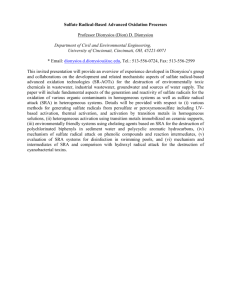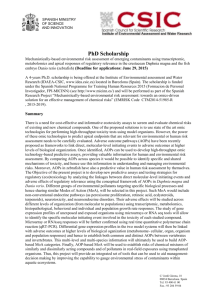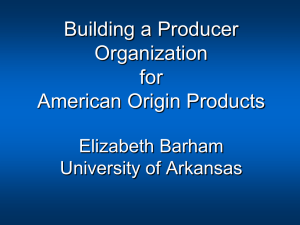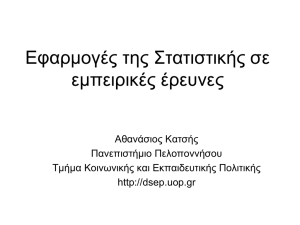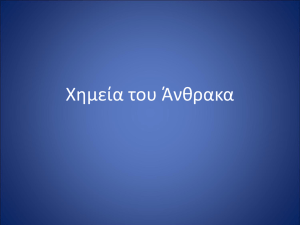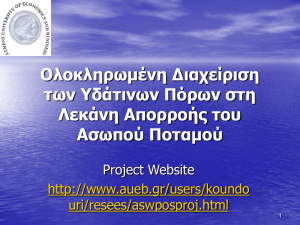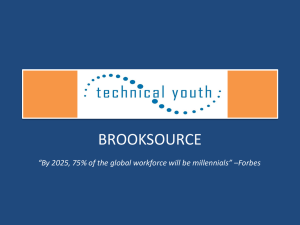More Info
advertisement
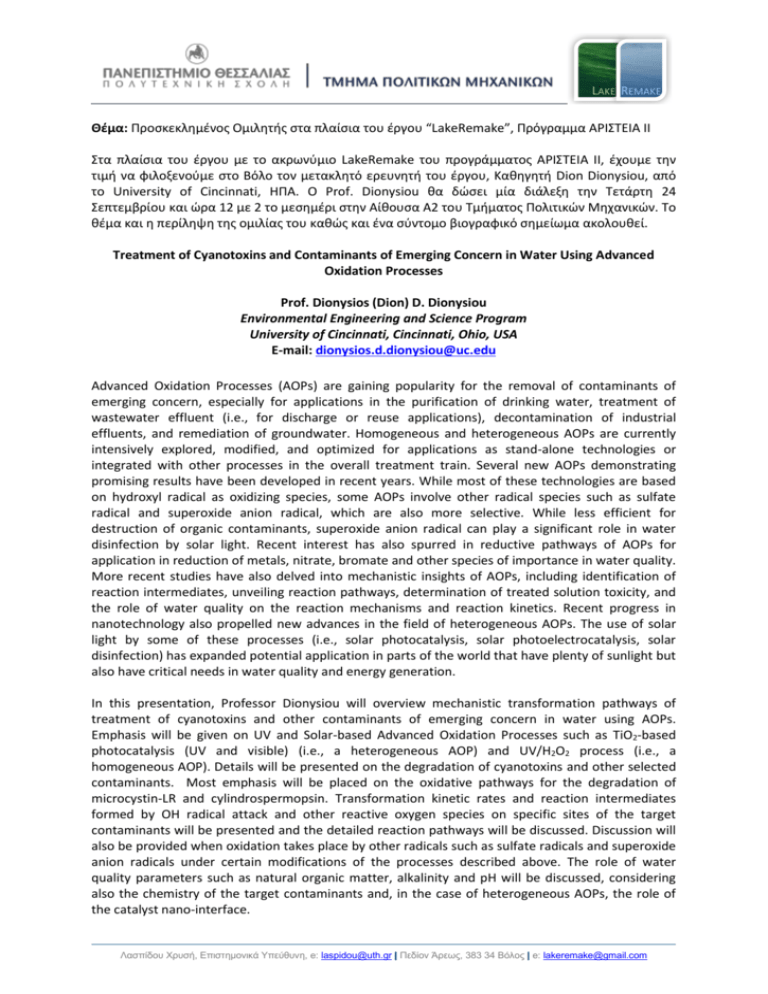
LAKE REMAKE Θέμα: Προσκεκλημένος Ομιλητής στα πλαίσια του έργου “LakeRemake”, Πρόγραμμα ΑΡΙΣΤΕΙΑ ΙΙ Στα πλαίσια του έργου με το ακρωνύμιο LakeRemake του προγράμματος ΑΡΙΣΤΕΙΑ ΙΙ, έχουμε την τιμή να φιλοξενούμε στο Βόλο τον μετακλητό ερευνητή του έργου, Καθηγητή Dion Dionysiou, από το University of Cincinnati, ΗΠΑ. Ο Prof. Dionysiou θα δώσει μία διάλεξη την Τετάρτη 24 Σεπτεμβρίου και ώρα 12 με 2 το μεσημέρι στην Αίθουσα Α2 του Τμήματος Πολιτικών Μηχανικών. Το θέμα και η περίληψη της ομιλίας του καθώς και ένα σύντομο βιογραφικό σημείωμα ακολουθεί. Treatment of Cyanotoxins and Contaminants of Emerging Concern in Water Using Advanced Oxidation Processes Prof. Dionysios (Dion) D. Dionysiou Environmental Engineering and Science Program University of Cincinnati, Cincinnati, Ohio, USA E-mail: dionysios.d.dionysiou@uc.edu Advanced Oxidation Processes (AOPs) are gaining popularity for the removal of contaminants of emerging concern, especially for applications in the purification of drinking water, treatment of wastewater effluent (i.e., for discharge or reuse applications), decontamination of industrial effluents, and remediation of groundwater. Homogeneous and heterogeneous AOPs are currently intensively explored, modified, and optimized for applications as stand-alone technologies or integrated with other processes in the overall treatment train. Several new AOPs demonstrating promising results have been developed in recent years. While most of these technologies are based on hydroxyl radical as oxidizing species, some AOPs involve other radical species such as sulfate radical and superoxide anion radical, which are also more selective. While less efficient for destruction of organic contaminants, superoxide anion radical can play a significant role in water disinfection by solar light. Recent interest has also spurred in reductive pathways of AOPs for application in reduction of metals, nitrate, bromate and other species of importance in water quality. More recent studies have also delved into mechanistic insights of AOPs, including identification of reaction intermediates, unveiling reaction pathways, determination of treated solution toxicity, and the role of water quality on the reaction mechanisms and reaction kinetics. Recent progress in nanotechnology also propelled new advances in the field of heterogeneous AOPs. The use of solar light by some of these processes (i.e., solar photocatalysis, solar photoelectrocatalysis, solar disinfection) has expanded potential application in parts of the world that have plenty of sunlight but also have critical needs in water quality and energy generation. In this presentation, Professor Dionysiou will overview mechanistic transformation pathways of treatment of cyanotoxins and other contaminants of emerging concern in water using AOPs. Emphasis will be given on UV and Solar-based Advanced Oxidation Processes such as TiO2-based photocatalysis (UV and visible) (i.e., a heterogeneous AOP) and UV/H2O2 process (i.e., a homogeneous AOP). Details will be presented on the degradation of cyanotoxins and other selected contaminants. Most emphasis will be placed on the oxidative pathways for the degradation of microcystin-LR and cylindrospermopsin. Transformation kinetic rates and reaction intermediates formed by OH radical attack and other reactive oxygen species on specific sites of the target contaminants will be presented and the detailed reaction pathways will be discussed. Discussion will also be provided when oxidation takes place by other radicals such as sulfate radicals and superoxide anion radicals under certain modifications of the processes described above. The role of water quality parameters such as natural organic matter, alkalinity and pH will be discussed, considering also the chemistry of the target contaminants and, in the case of heterogeneous AOPs, the role of the catalyst nano-interface. Λασπίδου Χρυσή, Επιστημονικά Υπεύθυνη, e: laspidou@uth.gr | Πεδίον Άρεως, 383 34 Βόλος | e: lakeremake@gmail.com Dionysios (Dion) D. Dionysiou Ph.D. – Short Bio Environmental Engineering and Science Program University of Cincinnati, Cincinnati, Ohio, USA E-mail: dionysios.d.dionysiou@uc.edu Professor Dionysiou was born on the Island of Cyprus. He is currently a UNESCO Chair Professor on “Water Access and Sustainability” and a Herman Schneider Professor of Environmental Engineering at the University of Cincinnati where he teaches courses on drinking water quality and treatment, advanced unit operations for water treatment, advanced oxidation technologies, and physical-chemical processes for water quality control. His research interests include treatment of water contaminated by harmful algal blooms with conventional and advanced technologies, advanced technologies for water treatment, advanced oxidation technologies, transition metal-based chemical oxidation, and nanotechnology. Dr. Dionysiou is the author or coauthor of over 200 refereed journal publications, over 90 conference proceedings, 17 book chapter publications, 17 editorials, and more than 450 presentations. He has received funding from NSF, US EPA, NASA, NOAA/CICEET, USGS, USDA, Cyprus Research Foundation, and DuPont. He is currently one of the editors of Chemical Engineering Journal (Elsevier), Editor of the Journal of Advanced Oxidation Technologies, and Special Issue Editor and Associate Editor for the Journal of Environmental Engineering (ASCE). He is a member of the Editorial Boards of ten other journals. He has previously served as Associate Editor of Water Environment Research (WEF) (2006-2011) and as member of the Editorial Board of Environmental Progress (now renamed as Environmental Progress and Sustainable Energy) (AIChE) (2003-2009). He is program chair of the Environmental Chemistry Division of ACS and is a member of many committees of several professional societies (i.e., ACS, AEESP, AWWA, WEF, IWA). Dr. Dionysiou has been featured in several international symposia, professional meetings, and scientific publications, including an interview on “Cleaning up water” published on July 5, 2011 in the Chemistry World magazine of the Royal Society of Chemistry. http://www.rsc.org/chemistryworld/News/2011/July/05071101.asp. Το έργο υλοποιείται στο πλαίσιο της Πράξης «ΑΡΙΣΤΕΙΑ ΙΙ» του Επιχειρησιακού Προγράμματος «Εκπαίδευση και Δια Βίου Μάθηση και συγχρηματοδοτείται από την Ευρωπαϊκή Ένωση (Ευρωπαϊκό Κοινωνικό ΤαμείοΕΚΤ) και από εθνικούς πόρους.
